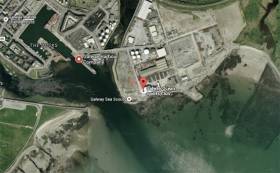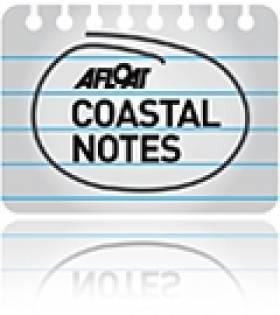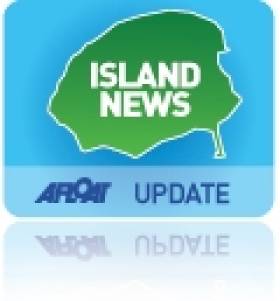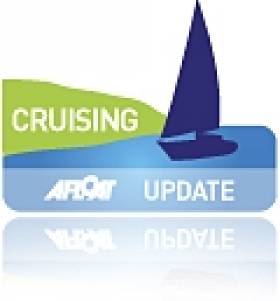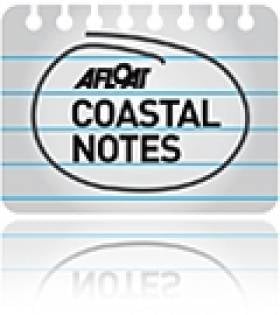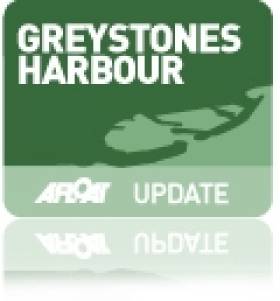Displaying items by tag: Slipway
Cork Harbour Slipway Extension at Monkstown Bay
Monkstown Bay in Cork Harbour is getting a slipway extension which will improve boat launching and recovery. The previously narrower slipway is being renewed and widened.
The slipway is at the upriver side of the Sand Quay which is primarily used by Monkstown Bay Sailing Club for launching dinghies, but it is a public slipway, also generally available.
MSBC has a club hut for race operations on the Quay. Its clubhouse is a short distance away at De Vesci Place in the village.
Galway Blocks Docks Slipway After Buncrana Tragedy
#Galway - Galway Harbour Company has blocked open access to a slipway in Galway Docks weeks after the Buncrana tragedy, as the Connacht Tribune reports.
The move was made a month after five members of the same family, including three children, died after their car slipped into Lough Swilly from the open slipway at Buncrana, Co Donegal on Sunday 20 March.
Galway's docks slipway had been used freely by recreational boaters – but as of last Thursday (21 April) local sailing clubs have been informed that the slipway can only be used with permission.
Access times have also been restricted to 9am-5pm on weekdays and by appointment on Saturdays in what the harbour company says is a move to avoid "risk to life".
But one local user has branded the locking-up of the slipway as "ridiculous" and said "there should have been a more measured response and consultation".
The Connacht Tribune has much more on the story HERE.
Funding Allocated for Works at Kilkee Pier & Slipway
Clare County Council today confirmed the Department of Agriculture, Food & the Marine has approved its application for funding for coastal infrastructure work improvements at Kilkee, Co Clare.
The Local Authority says the funding will go towards providing a new entrance to the slipway and pier area in Kilkee.
Cyril Feeney, Area Engineer, West Clare Municipal District, commented: "This proposed new entrance will address a long standing issue of access to the pier and slipway area through the existing overhead barriers at the East End car park, whilst also separating the marine and leisure boating activity from the general car parking area."
"These proposed works, which have been discussed with Elected Members, Kilkee Development Association and users of the pier, will allow for controlled access to the pier and slipway and also provide additional security to the area with the installation of CCTV and lighting," he added.
Weather permitting, Clare County Council anticipates that the proposed works will commence in the next fortnight.
#dunmoreeast – The Minister for Agriculture, Food and the Marine, Simon Coveney TD, today announced details of a €4m dredging project at Dunmore East Fishery Harbour Centre on the occasion of the official opening of a €450,000 renovation of the Marine Leisure Area at the western end of the harbour.
At the opening, the Minister said "I am delighted to officially open this. The completion of this project adds greatly to the Harbour for marine activities generally. This end of the Harbour was in need of revamping for some time, and I prioritised works to make it a fit for purpose amenity which will benefit and promote the marine leisure industry in this area".
Leisure activity in Dunmore East has been increasing substantially in recent years with 180 visiting yachts from all over Ireland and abroad using the harbour in 2013, more than a threefold increase on previous years. Cruise line passengers nearly doubled in 2013 to 9,500 and with the newly renovated slipway it is expected that usage by members of the public will double in 2014 from around 600 in 2013.
The €450,000 renovation included extending the existing slipway, widening it from five to twelve metres, resurfacing and generally improving vehicle and pedestrian access, the development of a promenade with street lighting, improved access to the beach, and a rock armour embankment to protect the development from severe weather conditions.
Commenting on the works the Minister said "This is an excellent piece of infrastructure and is now a top class amenity which will lend itself to the further development of the leisure industry in Dunmore East, and the spin off that will have for tourism and jobs locally".
Announcing the €4m dredging project for Dunmore East to resolve the impacts of years of siltation in the harbour, which has restricted vessel traffic and made manoeuvrability and fish landings problematic for fishermen the Minister said "This significant investment in Dunmore East from the 2014 Fishery Harbour Capital Programme is an indication of this Government's commitment to the fishing industry in the South East. When complete, not only will the harbour be more accessible to larger vessels, landing times and management will be much improved as will the usability of the syncrolift".
Latest figures indicate that the value and volume of fish landings in Dunmore East has been on the increase for a number of years. Between 2010 and 2013 landings increased by 40% from 8,387 tonnes to an estimated 11,718 tonnes. The equivalent value of these landings went from €13.7m in 2010 to an estimated €17.5m in 2013 an increase of 28%.
The Minister went on to say "Taking account of the increased level of fish landings I am conscious of the need to dovetail the much needed dredging works with the seasonal work patterns of the fishing industry to cause as little disruption as possible. With that in mind every effort will be made to ensure that the works will be completed in advance of the important herring fishery later in the year".
Groundwork for the project is well advanced; a public procurement exercise will be initiated in May, with a view to awarding the contract in time for an August commencement date.
Concluding the Minister said "The development and upkeep of Dunmore East as a state of the art Fishery Harbour Centre, supporting a broad range of marine related activities is and will remain an ongoing process. These two major projects and the recent installation of floating pontoons within the Harbour are part of a long term strategy to deliver on the potential of Dunmore East for job creation for the fishing industry and as a marine leisure and tourist destination".
Dalkey Island Harbour New Slipway Works Underway
#DalkeyIslandWorks - Work to upgrade the landing stage pier on Dalkey Island on south Dublin Bay have begun this Spring with completion due in May, writes Jehan Ashmore.
Dun Laoghaire Rathdown County Council are confident that following the upgraded harbour, a licensed passenger-only ferryboat service from Coliemore Harbour which is also to undergo some remedial work, will start this season after an absence of three years.
A foreshore license to permit the work on Dalkey Island, part of a recommendation of the island's management Conservation Plan, was signed in February by the Minister of State for Housing and Planning.
Work on the island harbour under the PART 8 scheme started as a priority before breeding season of rare bird species begins around May, as the small scenic island located only nine miles from Dublin City, is afforded EU designated status as a Special Protection Area (SPA).
This particular PART 8 programme only covers island issues among them plans to restore the Martello Tower and Gun Battery, though it is understood not St. Begnet's Church which is the responsibility of the OPW.
As previously reported on Afloat.ie, plans to the upgrade the island harbour which according to consultant report in 2012 estimated to be in the region of €228,000, has already seen the old pier-slipway demolished and the foundation in place for a new landing point pier and slipway structure laid down, facilitating easier access for all boat users.
In addition the work has to date involved widening and deepening the once narrower entrance to the island and a yet to be installed new feature of a navigational light marking the approaches of the new public amenity. The island harbour will be capable of berthing several small boats at the same time and not restricted as much to the previous extent of tidal variations.
It is understood that the construction process did not require helicopter-equipment lifts as previously reported, unlike the last major upgrade in 1994 when a helicopter performed frequent flights.
On this occasion the harbour works involve the Cork registered Kismet, a self-propelled pontoon loaded heavy plant machinery to the island and where work has taken a steady pace, notably due to favourable weather conditions.
Over the last two years, the Coliemore Harbour Users Action Group representing a diverse range of local groups throughout Dalkey led a campaign with support of local councillors to ensure that the core issue of a commercial licensed ferryboat service be reinstated from Coliemore Harbour.
There were concerns that an alternative new service instead operating from Dun Laoghaire Harbour taking around 20-25 minutes would replace Coliemore Harbour, as DLRCoCo had cited concerns over boat safety access, public liabilty insurance and harbour repair costs, following a consultants structural report into the fabric of the harbour completed in 1868.
However, despite such concerns, funding of around €63,000 for short-term works have been made available so to address safety access issues at Coliemore Harbour, the traditional mainland embarkation to Dalkey Island. Such works will permit the restoration of the licensed boat service in readiness for this summer.
A boat has been inspected by the Marine Survey Office at the Department of Transport, which will enable up to six passengers to be ferried on the convenient short five-minute hop across Dalkey Sound.
Further works at Coliemore Harbour, over the medium and long term will also be carried out to consolidate the future of one of Dublin Bay's most attractive small stone-cut harbours.
The harbour is not only a popular place for locals and visitors alike but is as a location widely featured for film shoots, documentaries and TV commercials.
#trailersailer – Ireland's coastline is one of the world's finest cruising grounds. Yet there are long lengths of the coast that rarely see a visiting cruiser. It is not that the area is inhospitable, although the weather can be challenging. Safe anchorages and sheltered harbours are numerous, the welcome on shore is legendary. The plain fact is that, for many of us the west coast of Ireland is very much the Far West.
A circumnavigation of the island is over 700 miles, roughly the same distance as the Fastnet Race, longer than the Sydney-Hobart, or the Newport-Bermuda. For the East Coast cruising sailor with a fortnight to spare Wales, Cornwall or Scotland are nearer, and, in the prevailing westerlies, easier to reach. Cork sailors can explore West Cork or South Kerry, but a trip to Galway is a serious voyage, with a long stretch of coast offering little or no shelter.
Any plan to develop cruising from Cork to Donegal must take account of the distances involved. One solution would be to develop marinas and encourage boat owners to keep their boat there for all or part of the year. However, maintaining a boat that is several hours drive from home is never easy. Those who are fortunate to keep boats in France, Portugal or elsewhere can depend on a well developed network of professionals, with workshops in the harbour area, to carry out necessary work. Unfortunately, marinas in Ireland are conceived more as a pretext to develop shore-side housing, rather than as essential industrial infrastructure. Boatyards and luxury apartments do not make good neighbours!
Basing the boat on the west coast for a month or two is no less problematic. Finding a window of opportunity, and the crew, for the delivery trip there and back, is never easy. A 300 mile cruise is, for many, already a summer holiday in itself! Furthermore, sailors can be reluctant to abandon the short but intense racing season, especially on the East Coast.
There is an alternative: the trailer-sailer, or, as well known nautical author Sam Llewelyn prefers – the "Minimum Boat". For an owner wishing to explore the nooks and crannies of the Irish coast such boats have huge advantages. The ability to tow a boat to a suitable area greatly extends the range of possible cruising grounds. The flexibility of such a mobile boat means that plans can be changed easily. You may have planned a weekend trip to the Aran Islands, but if the forecast is for squalls, rain and a huge swell it is no great problem to divert to Lough Derg, or even to "go foreign" and explore Lough Erne. How often is it set to rain in Kerry while Donegal basks in sunshine (or vice versa). Until you choose which exit to take off the motorway, the "Minimum Boat" owner is not committed to any one destination.
In addition, a ferry trip to Cherbourg or Roscoff opens up the whole of Europe. Personally I quite fancy exploring the Venice Lagoon or the Skerries of the northern Baltic.
In choosing a "Minimum Boat" compromises have to be made, between the boats nautical capacities, convenience when rigging, launching and recovering and the trappings of modern comforts. Many commonly used boats are no longer than 21-22 foot, and no more than 2 tons. Increasingly water ballast is used, reducing the towing weight, making it possible to tow and launch somewhat larger boats.
Obviously, a boat this size will not have standing headroom throughout. Farewell the power shower, the microwave and the master cabin. However, there is great pleasure in rediscovering the little luxuries – making that first tea or coffee whilst still in your sleeping bag, stepping ashore from the bow of the boat on a sheltered beach or settling down for the night in an anchorage known only to those that go to sea in kayaks or RIBs. Not forgetting that keeping the boat in the garden is a great convenience when maintenance is required.
Cruising on boats this size is more about exploring the coast and the islands, rather than passage making. In fact the whole point of the trailer-sailer is that long passages are made by road. The most difficult moments of any holiday will be launching and recovery. Many cars can cope with towing a fairly substantial boat. However, slipways are often narrow and steep. Alexander Nimmo and his fellow engineers of the 19th Century singularly failed to take account of the constraints of launching a small yacht from a road trailer when engaged in building so many harbours, piers and slips that are still the backbone of our nautical infrastructure. If a Minimum Boater has to rely on launching only at well-equipped boatyards or clubs then the range of accessible cruising areas is limited.
A major contribution to the development of trailer sailing could be made at little cost:
⁃ by publishing a comprehensive list of slipways, including details such as the angle of the slip (preferably between 7° and 12°), launching conditions and information on safe parking;
⁃ identifying a local tractor owner who would, for a small charge, tow the trailer down the slip. Ideally, they would also be able to offer safe parking for for car and trailer. Trailer-sailors would be happy to pay for such a service. Obviously, there will be considerations of liability and insurance, but in a period when small farmers, building contractors and other small businesses are facing difficulties, launching and recovering could provide a small but useful revenue stream.
To conclude by an (apocryphal) example:
Sitting in the bar of a well-known yacht club club in Greater Dublin two boat owners are discussing the possibility of viewing from the comfort of their own cockpit the in-port race in Galway Bay when the VOR fleet is in town. One owns a well-found 35 ft yacht that competes in local races. His owner reckons that in order to be sure of getting to Galway in time, and get the boat back, he will take a fortnight's holiday. He already organising a delivery crew, one for each trip, there and back, with the family driving down for the weekend. It is proving difficult to find a berth in Galway and he may have to anchor off somewhere.
His friend has a French-built 21 foot trailer-sailer that has proved competitive in club racing, and did well when he towed the boat to the UK to compete in Cowes Week. His plan is to lift out on Thursday evening after racing and drive down early Friday morning. He intends to launch in Kinvara, having checked the slip on Google Earth, and sail across to Galway. When he called the organisers they told him they would have no problem finding a berth for such a tiny yacht! The in-port race is on Saturday. The plan is to party in Galway on Saturday and sail back to Kinvara on Sunday. With HW just after 2130 there will be no problem getting back to Dublin sometime (possibly late) on Sunday night.
Small is beautiful. More to the point a small trailer friendly yacht is the passport to spending more time in some of the world's most spectacular seascapes – Magheramore
Dream Home at Water's Edge on Great Island
#WATERFRONT PROPERTY - A beautifully restored period house on 14 acres of Great Island in Co Cork could be a dream home for any big spender.
Accepting offers over €3 million, the house at East Grove believed to date from the early 19th century and is constructed of stone under a slate roof, with attractive shallow gables.
Approached via a long wooded avenue, the house commands a magnificent position overlooking a peaceful inlet of Cork Harbour.
Accommodation comprises five reception rooms, including a drawing room, dining room and library; six bedrooms including a master bedroom with ensuite; and a fully fitted kitchen with black granite countertops and pantry.
Outside there is a courtyard with stables, a work shop and storerooms, as well as a one-bedroom apartment arranged on two floors, while further accommodation is available in the two-bedroom gate lodge with its own gardens.
Other amenities include a delightful walled garden, an indoor swimming pool, tennis courts and a boathouse with private harbour and boat slipway with a floating yacht pontoon and moorings.
Viewing of East Grove is strictly by appointment only with joint agents Knight Frank and Dominic Daly. More on the property is available HERE.
Howth Juniors Win 19-Boat Greystones Feva Event
Seven races were sailed and Howth visitors David Johnston and Louise Flynn Byrne emerged clear winners from Dun Laoghaire's Stephen Judge and Patrick Riordan by a margin of 12 points. Full results here.
Coastal Harbours Benefit from Infrastructure Funding
Malahide is one of over a dozen harbours around the coast to benefit from an announcement by Sean Connick TD, Minister of State at the Department of Agriculture, Fisheries and Food today that funding has been approved for harbour development projects in Local Authority owned harbours under the Fishery Harbour and Coastal Infrastructure Development Programme 2010.
Funding has been approved for projects that have been identified as priorities by each of the five Local Authorities listed below. Up to 75% of the cost of an approved project (subject to the maximum figure approved) will be available for each project with the Local Authority providing the balance. The project must be completed and funding drawn down before the end of the current calendar year. The projects are located in harbours around our coastline that are in Local Authority ownership.
Minister Connick said “The Local Authority owned fishing harbours supplement and underpin the activities undertaken in our Department of Agriculture, Fisheries and Food owned Fishery Harbour Centres. These harbours are of great importance to the fishing and aquaculture industries and provide much needed employment and support for economic activity in our coastal communities. I am delighted to be able to announce the provision of this funding to enhance and develop these facilities”.
The following is a list of the Local Authorities that have been approved funding:
|
Local Authority |
Approved Funding |
||
|
FINGAL COUNTY COUNCIL |
|||
|
Malahide - Repair to slipway |
€55,875 |
||
|
SLIGO COUNTY COUNCIL |
|||
|
Mullaghmore Harbour - Dredging of harbour |
€90,000 |
||
|
CORK COUNTY COUNCIL |
|||
|
Ballycotton - Breakwater Emergency works |
€225,000 |
||
|
WEXFORD COUNTY COUNCIL |
|||
|
Fethard harbour 1 - Fishing harbour and slipway study |
€18,750 |
||
|
Fethard Harbour 2 - Fishing harbour and slipway |
€7,500 |
||
|
Kilmore Quay Harbour - Provide a new laydown area at the end of West Pier |
€54,750 |
||
|
Courtown Harbour 1 - Health & Safety improvements |
€18,750 |
||
|
Duncannon & Hook Peninsula Piers - New CCTV system & Harbour Repairs |
€56,250 |
||
|
WEST CORK COUNTY COUNCIL |
|||
|
Castletownbere - Bank Harbour |
€18,422 |
||
|
Bantry- Doneen Pier |
€23,288 |
||
|
Schull - Lahertanavally Pier |
€24,375 |
||
|
Schull - Ballycummisk Pier |
€19,916 |
||
|
Castletownbere - Trafrask Pier |
€18,422 |
||
|
Western Division - Safety Works |
€46,369 |
||
|
Bantry Pier - Public Toilets |
€30,000 |
||
|
|
|
|
|
|
|
|
Total Estimated Cost |
€707,667 |
Aerial Photo Shows New Greystones Slipway
The new public slipway at the still under construction Greystones Harbour in Co. Wicklow is now operational and local clubs have been given access. It is now possible to launch three boats at one time even at low water (when most slips run out of water). The latest aerial photo of the site from July 23rd is published below showing the new slipway and the marina basin.




























